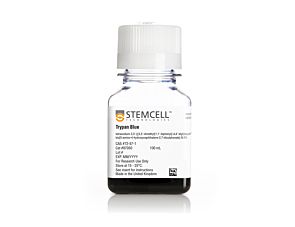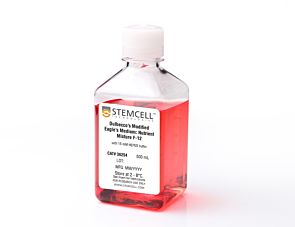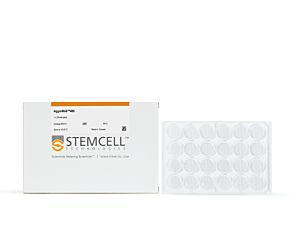STEMdiff™ Motor Neuron Differentiation Kit
Differentiation kit for the generation of motor neurons from hPSCs
Request Pricing
Thank you for your interest in this product. Please provide us with your contact information and your local representative will contact you with a customized quote. Where appropriate, they can also assist you with a(n):
Estimated delivery time for your area
Product sample or exclusive offer
In-lab demonstration
-
 Trypan Blue
Trypan BlueReagent for counting viable mammalian cells
-
 DMEM/F-12 with 15 mM HEPES
DMEM/F-12 with 15 mM HEPESDulbecco's Modified Eagle's Medium/Nutrient Ham's Mixture F-12 (DMEM/F-12) with 15 mM HEPES buffer
-
 D-PBS (Without Ca++ and Mg++)
D-PBS (Without Ca++ and Mg++)Dulbecco’s phosphate-buffered saline without calcium and magnesium
-
 Y-27632 (Dihydrochloride)
Y-27632 (Dihydrochloride)RHO/ROCK pathway inhibitor; Inhibits ROCK1 and ROCK2
-
Labeling Antibodies
Compatible antibodies for purity assessment of isolated cells
Overview
For further maturation of motor neurons generated with this kit, pair with the STEMdiff™ Motor Neuron Maturation Kit to produce >40% ChAT cells in an additional 14 days.
Data Figures

Figure 1. Schematic for the STEMdiff™ Motor Neuron Culture System Protocol
Motor neurons can be generated from human pluripotent stem cells (hPSCs) in 14 days. The resulting cells can then be matured for an additional 14 or more days using STEMdiff™ Motor Neuron Maturation Kit.

Figure 2. Pure Population of Motor Neuron Progenitors Are Generated Using the STEMdiff™ Motor Neuron Differentiation Kit
hPSCs from a variety of cell lines were differentiated to motor neuron progenitors using the STEMdiff™ Motor Neuron Differentiation Kit in an ultra-low attachment or an AggreWell™400 plate. (A) hPSCs maintained in mTeSR™1 or mTeSR™ Plus were aggregated to EBs with the STEMdiff™ Motor Neuron Differentiation Kit. On Day 9, EBs were dissociated into single cells and replated for adherent culture.The resulting cultures contain a population of cells expressing motor neuron progenitor marker OLIG2 (red) and are negative for spinal interneuron marker NKX2.2 (green). Nuclei are labeled with Hoechst (blue). (B) The percentage expression of OLIG2 and negative controls NKX2.2, FOXG1, OTX1, and OTX2 in the resulting cultures, derived from 2 hES (H1 and H7) and 2 hiPS (WLS-1C and STiPS-M001) cell lines, were quantified. This differentiation generated OLIG2+ motor neuron progenitors (83.20% ± 2.890%, mean ± SEM; n=4 cell lines, 2 replicates per condition). Numbers are % positive of total Hoechst-positive cells. hPSCs = human pluripotent stem cells; EB = embryoid body

Figure 3. Pure Population of Post-Mitotic Motor Neurons Are Generated Using the STEMdiff™ Motor Neuron Differentiation Kit
Motor neuron progenitors derived from a variety of cell lines were transitioned to post-mitotic motor neurons using the STEMdiff™ Motor Neuron Differentiation Kit. (A) Post-mitotic motor neurons were generated by Day 14 after hPSCs were differentiated with the STEMdiff™ Motor Neuron Differentiation Kit. The resulting cultures contain a population of cells expressing neuronal identity marker βIII-TUB (green), mature motor neuron marker HB9 (red), and (B) ISL1 (red). Nuclei are labeled with Hoechst (blue). (C) The percentage expression of βIII-TUB, ISL1, and HB9 in the resulting cultures, derived from 3 hES (H1, H7, and H9) and 3 hiPS (WLS-1C, STiPS-M001, and STiPS-R038) cell lines, were quantified. This differentiation generated βIII-TUB+ (92.59% ± 1.079%, mean ± SEM; n=6 cell lines, 2 replicates per condition), ISL1+ (55.99% ± 3.723%, mean ± SEM), and HB9+ (65.17% ± 3.514%, mean ± SEM) motor neurons. Numbers are % positive of total Hoechst-positive cells. hPSC = human pluripotent stem cell

Figure 4. STEMdiff™ Motor Neuron System Generates Motor Neurons Patterned to the Cervical Axis
hPSCs from a variety of cell lines were differentiated to motor neuron progenitors using the STEMdiff™ Motor Neuron Differentiation Kit. Expression levels of the resulting cultures, derived from 2 hES (H1 and H7) and 2 hiPS (STiPS-M001 and STiPS-R038) cell lines, were measured by qPCR and hPSC-derived forebrain progenitor cells were used as a control. Analysis of Day 9 motor neuron progenitors showed high expression of cervical AP axis HOXA5 (n = 4) relative to hPSC. hPSCs = human pluripotent stem cells; qPCR = quantitative polymerase chain reaction; AP = anteroposterior

Figure 5. hPSC-Derived Motor Neurons Can Be Matured in STEMdiff™ Motor Neuron Maturation Medium
Motor neuron progenitors derived from a variety of cell lines were matured using the STEMdiff™ Motor Neuron Maturation Kit. (A) Mature motor neurons were generated after hPSCs were cultured with the STEMdiff™ Motor Neuron Differentiation Kit for 14 days and then the STEMdiff™ Motor Neuron Maturation Kit for an additional 14 days. The resulting cultures contain a population of cells expressing neuronal identity marker βIII-TUB (green), mature motor neuron markers HB9 (red), (B) SYNAPSIN (red), and MAP2 (green), as well as (C) cholinergic neuron marker ChAT (green). Nuclei are labeled with Hoechst (blue). (D) The percentage expression of ChAT, HB9, and βIII-TUB in the resulting cultures, derived from 2 hES (H1 and H7) and 2 hiPS (STiPS-R038 and STiPS-M001) cell lines, were quantified. This differentiation generated ChAT+ (65.16% ± 3.737%, mean ± SEM; n=4 cell lines, 2 replicates per condition), HB9+ (79.58% ± 2.570%, mean ± SEM), and βIII-TUB+ (86.56% ± 2.331%, mean ± SEM) motor neurons. Numbers are % positive of total Hoechst-positive cells. hPSC = human pluripotent stem cell

Figure 6. hPSC-Derived Motor Neurons Matured in STEMdiff™ Motor Neuron Maturation Medium Produces Cholinergic Neurons
hPSCs from a variety of cell lines were differentiated to motor neurons using the STEMdiff™ Motor Neuron Differentiation Kit for 14 days and then the STEMdiff™ Motor Neuron Maturation Kit for an additional 14 days prior to analysis. Expression levels of the resulting cultures, derived from 3 hES (H1, H7, and H9) and 3 hiPS (WLS-1C, STiPS-M001, and STiPS-R038) cell lines, were measured by qPCR and hPSC-derived forebrain neurons were used as a control. Analysis of Day 28 mature motor neurons showed higher expression of ChAT (n = 5, P<.0001, Two-way ANOVA with Sidak's multiple comparisons test). hPSCs = human pluripotent stem cells; qPCR = quantitative polymerase chain reaction; ChAT = choline acetyltransferase

Figure 7. hPSC-Derived Motor Neurons Can Be Co-Cultured with hPSC-Derived Myotubes for In Vitro Modeling
hPSCs were differentiated to motor neurons using the STEMdiff™ Motor Neuron Differentiation Kit and Maturation Kit. hPSC-derived myogenic progenitors were generated using the STEMdiff™ Myogenic Progenitor Kit and then induced to differentiate into myotubes using MyoCult™ Differentiation Medium. The resulting co-culture contains a population of cells expressing neuronal identity marker βIII-TUB (red), mature motor neuron marker ISL1 (blue), and AChR (green). Arrows indicate neuromuscular junctions. hPSC = human pluripotent stem cell; AChR = acetylcholine receptor.
Protocols and Documentation
Find supporting information and directions for use in the Product Information Sheet or explore additional protocols below.
Applications
This product is designed for use in the following research area(s) as part of the highlighted workflow stage(s). Explore these workflows to learn more about the other products we offer to support each research area.
Resources and Publications
Educational Materials (6)
Related Products
-
 BrainPhys™ Neuronal Medium
BrainPhys™ Neuronal MediumSerum-free neurophysiological basal medium for improved neuronal function
-
 STEMdiff™ Forebrain Neuron Differentiation ...
STEMdiff™ Forebrain Neuron Differentiation ...Differentiation kit for the generation of neuronal precursors from human ES and iPS cell-derived neural progenitor cells
-
 STEMdiff™ Sensory Neuron Differentiation Ki...
STEMdiff™ Sensory Neuron Differentiation Ki...Differentiation kit for the generation of sensory neuronal precursors from human iPS cell-derived neural crest cells
-
 STEMdiff™ Motor Neuron Maturation Kit
STEMdiff™ Motor Neuron Maturation KitCell culture medium kit for the maturation of hPSC-derived motor neurons
-
 AggreWell™400
AggreWell™400Microwell culture plates for easy and reproducible production of embryoid bodies and spheroids
Item added to your cart

STEMdiff™ Motor Neuron Differentiation Kit
Quality Statement:
PRODUCTS ARE FOR RESEARCH USE ONLY AND NOT INTENDED FOR HUMAN OR ANIMAL DIAGNOSTIC OR THERAPEUTIC USES UNLESS OTHERWISE STATED. FOR ADDITIONAL INFORMATION ON QUALITY AT STEMCELL, REFER TO WWW.STEMCELL.COM/COMPLIANCE.







